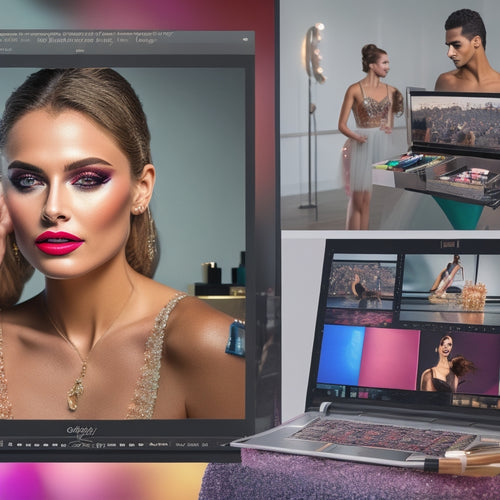
Top Music Editing Software for Choreographers
Share
As a choreographer, you require music editing software that can deliver precise control over rhythm, timing, and tempo, ensuring your dance routines are perfectly synchronized with the music. Look for software that offers advanced rhythm adjustments, beat synchronization, and precise control over time stretching and pitch shifting. Top picks for belly dancers include Ableton Live, Logic Pro, and FL Studio, which provide user-friendly interfaces and advanced audio editing tools. To optimize your workflow, utilize time-saving tricks like beat mapping, audio looping, and mastering keyboard shortcuts. Explore further to discover the perfect software for your choreography needs.
Key Takeaways
• Choreographers require music editing software that delivers precise and repeatable structures for predictable rhythm and timing.
• Top picks for choreographers include Ableton Live, Logic Pro, and FL Studio, which offer advanced rhythm adjustments and beat synchronization.
• A user-friendly interface is essential, providing intuitive navigation, customizable workflows, and drag-and-drop functionality for efficient editing.
• Advanced audio editing tools, such as multi-band compressors and precision EQs, refine music to complement choreography and optimize performances.
• Time-saving tricks like beat mapping, audio looping, and keyboard shortcuts streamline workflow, allowing choreographers to focus on perfecting dance routines.
Essential Features for Dance Tracks
When creating a dance track, you'll need software that can deliver a precise and repeatable structure, as choreographers require a predictable rhythm and timing to perfect their routine.
To achieve this, you'll want software that offers advanced rhythm adjustments, allowing you to fine-tune the tempo and meter of your track. This feature is vital, as even slight variations in rhythm can throw off a choreographer's entire routine.
Another essential feature is beat synchronization, which guarantees that your track stays in time with the choreographer's movements. This feature is particularly important for complex routines, where even a slight deviation from the beat can cause confusion.
By synchronizing your track's beat with the choreographer's movements, you can create a seamless and polished performance.
When selecting music editing software, look for these key features to make sure that your tracks meet the high standards of professional choreographers. With advanced rhythm adjustments and beat synchronization, you'll be able to create tracks that are both predictable and precise, giving choreographers the confidence to perfect their routine.
Top Picks for Belly Dancers
You'll find that certain music editing software is better suited for belly dancers, who require a high degree of precision and control over the rhythm and tempo of their tracks. When working with Middle Eastern rhythms, you need software that can accurately capture the nuances of these complex rhythms.
For Fusion styles, which often blend traditional and modern elements, you'll want software that allows for smooth shifts and layering of different sounds. In this case, software with advanced tempo and time signature management features is essential.
You'll want to look for software that allows for precise control over time stretching and pitch shifting, ensuring that your tracks sound natural and authentic. Additionally, software with a robust effects library can help you create a rich, immersive sound that complements your choreography.
Some top picks for belly dancers include Ableton Live, Logic Pro, and FL Studio. Each of these software options offers advanced features that cater to the specific needs of belly dancers, allowing you to focus on perfecting your craft.
User-Friendly Editing Interfaces
Beyond the advanced features required for belly dance music editing, a user-friendly editing interface is essential for streamlining your workflow and minimizing distractions. As a choreographer, you need to focus on creating stunning routines, not wrestling with complicated software. A well-designed interface helps you stay focused on your art.
When evaluating music editing software, look for an intuitive design that makes it easy to navigate and find the tools you need. You should be able to customize the interface to fit your workflow, with options to adjust the layout, color scheme, and even keyboard shortcuts. This level of flexibility guarantees that you can work efficiently and effectively.
Some key features to look for in a user-friendly interface include:
- Drag-and-drop functionality for easy file management
- Customizable toolbar to prioritize your most-used tools
- Real-time feedback to confirm your edits are accurate and precise
Advanced Audio Editing Tools
As a choreographer, you require advanced audio editing tools to refine your belly dance music. These tools include multi-band compressors, spectral processors, and precision EQs that help you sculpt the perfect sound. These advanced tools enable you to fine-tune your music, ensuring it complements your choreography.
For instance, multi-band compressors allow you to control the dynamic range of your music, creating a more balanced sound. Spectral processors help you remove unwanted frequencies, resulting in a cleaner sound. Precision EQs enable you to make precise adjustments to your music's tone and timbre.
When it comes to live mixing, advanced audio editing tools are essential. They enable you to make adjustments on the fly, ensuring your music is always optimized for your performance. Additionally, advanced audio editing tools can aid in audio restoration, allowing you to rescue poor-quality recordings and breathe new life into them.
Time-Saving Music Editing Tricks
When editing music for choreography, utilizing time-saving tricks can greatly streamline your workflow, allowing you to focus on perfecting your dance routines.
One of the most effective ways to save time is by using Beat Mapping, which enables you to visually represent the rhythm and structure of your music. This allows you to quickly identify key elements, such as drum hits or vocal cues, and make precise edits accordingly.
Additionally, consider the following time-saving tricks to accelerate your music editing process:
-
Audio Looping: Create seamless loops of music to extend or shorten sections, ensuring a smooth flow that complements your choreography.
-
Identify and label key elements: Clearly mark important musical events, such as drops, builds, or breaks, to facilitate quick navigation and editing.
-
Use keyboard shortcuts: Master essential hotkeys to expedite tasks, like cutting, copying, and pasting audio segments, and maximize your productivity.
Frequently Asked Questions
Can I Use Music Editing Software on a Mobile Device?
You can use music editing software on a mobile device, but be aware of mobile limitations, such as processing power and screen size, which might hinder your workflow, especially when working on complex projects on the go.
Are Music Editing Software Subscriptions Worth the Cost?
"You're probably thinking, 'Do I really need to break the bank for music editing software?' But, let's do a cost analysis: weigh the financial benefits of subscriptions, like access to frequent updates and premium features, against the cost – it's worth it for professional results."
How Do I Protect My Edited Tracks From Copyright Infringement?
To safeguard your edited tracks from copyright infringement, you'll need to make sure you have proper licensing agreements in place or opt for royalty-free options, guaranteeing you're cleared for commercial use and avoiding legal issues.
Can I Collaborate With Others in Real-Time Using Music Editing Software?
You can collaborate with others in real-time using cloud-based music editing software, leveraging cloud partnerships to facilitate seamless remote workflows, ensuring secure and efficient teamwork while protecting your edited tracks from potential copyright issues.
Do I Need to Be a Musician to Use Music Editing Software Effectively?
You don't need to be a musician to wield music editing software effectively; think of it as holding a paintbrush - anyone can create, regardless of skill, as long as you grasp Musicality Basics, accessing Creative Freedom.
Related Posts
-

Learn Dance Makeup Artistry Online: A Step-by-Step Guide
You're about to begin an exciting journey to master the art of dance makeup online! First, you'll need to select the ...
-

Exclusive Crafting Files: Dance Mom Delight
Dance Mom Delight offers a wide collection of exclusive crafting files, providing users with a diverse range of digit...

